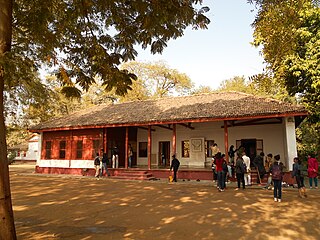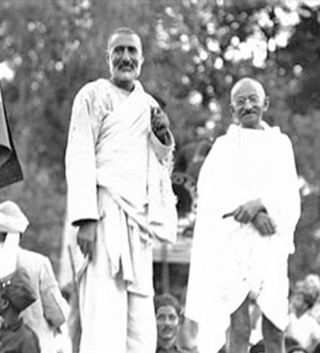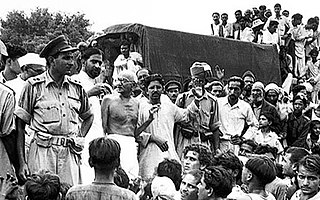
Sabarmati Ashram is located in the Sabarmati suburb of Ahmedabad, Gujarat, adjoining the Ashram Road, on the banks of the River Sabarmati, 4 miles (6.4 km) from the town hall. This was one of the many residences of Mahatma Gandhi who lived at Sabarmati (Gujarat) and Sevagram when he was not travelling across India or in prison. He lived in Sabarmati or Wardha for a total of twelve years with his wife Kasturba Gandhi and followers, including Vinoba Bhave. The Bhagavad Gita was recited here daily as part of the Ashram schedule.

Shambuka is an interpolated character, which is part of Uttara Kanda" found in the Valmiki Ramayana According to the story, Shambuka, a shudra ascetic, was killed by Rama for attempting to perform tapas in violation of dharma, resulting in the bad karma which caused the death of a Brahmin's son.

Gandhism is a body of ideas that describes the inspiration, vision, and the life work of M.K. Gandhi. It is particularly associated with his contributions to the idea of nonviolent resistance, sometimes also called civil resistance.
Narhari Dwarkadas Parikh was a writer, independence activist and social reformer from Gujarat, India. Influenced by Mahatma Gandhi, he was associated with Gandhian institutes throughout his life. He wrote biographies, edited works by associates and translated some works. His writing also reflected Gandhian influence.

The Champaran Satyagraha of 1917 was the first satyagraha movement led by Mahatma Gandhi in British India and is considered a historically important rebellion in the Indian independence movement. It was a farmer's uprising that took place in Champaran district of Bihar in the Indian subcontinent, during the British colonial period. The farmers were protesting against having to grow indigo with barely any payment for it.
Bengali author and statesman Rabindranath Tagore was a poet, philosopher, educationist and cultural reformer. He lived during the long period of Indian independence and was acquainted with several political leaders in Asia.

Malati Devi Choudhury was an Indian civil rights and freedom activist and Gandhian. She was born in 1904 in an upper middle class Brahmo family. She was the daughter of Barrister Kumud Nath Sen, whom she had lost when she was only two and a half years old, and Snehalata Sen, who brought her up.
Nautamlal Bhagavanji Mehta, or the Nagar Sheth of Jetpur was an Indian independence activist and a supporter of Mahatma Gandhi. He was also a prominent businessman and a pioneer of the Gandhian Movement in what is now Gujarat. He is also believed to be the first to bestow the title "Mahatma" to Gandhi, not Rabindranath Tagore, as many believe. Mehta wrote a manpatra using the term, which has been authenticated by the National Gandhi Museum in New Delhi. However there is a Genuine claim that the Peethadhipati of the Bhuvaneshwari Peeth in Gondal in Gujarat was the first person to bestow the title of Mahatma to Late Shri Mohandas Karamchand Gandhi, soon after he returned to India from South Africa. This can be verified from the present Pethadhipati of the Gondal Peeth.
Amlan Datta was an economist and educationist from West Bengal, India.
Gandhian economics is a school of economic thought based on the spiritual and socio-economic principles expounded by Indian leader Mahatma Gandhi. It is largely characterised by rejection of the concept of the human being as a rational actor always seeking to maximize material self-interest that underlies classical economic thinking. Where Western economic systems were based on what he called the “multiplication of wants,” Gandhi felt that this was both unsustainable and devastating to the human spirit. His model, by contrast, aimed at the fulfillment of needs – including the need for meaning and community. As a school of economics the resulting model contained elements of protectionism, nationalism, adherence to the principles and objectives of nonviolence and a rejection of class war in favor of socio-economic harmony. Gandhi's economic ideas also aim to promote spiritual development and harmony with a rejection of materialism. The term "Gandhian economics" was coined by J. C. Kumarappa, a close supporter of Gandhi.
G. Ramachandhran was a soldier for the Gandhian cause, social reformer and a teacher. With his wife, Dr. T. S. Soundram, daughter of T V Sundaram Iyengar, founder of TVS Group, he started the Gandhigram, Tamil Nadu in 1945. He authored several books. Viswabharati, Rabindranath Tagore's University, in Santhiniketan awarded him the higher title "Desikottama".

Jugatram Chimanlal Dave (1892–1985) was a Gandhian social activist, freedom fighter and author from Gujarat, India who is remembered for his social work among the tribals of southern Gujarat.
Krishna Kripalani was an Indian freedom fighter, author and parliamentarian. He wrote a number of books on Rabindranath Tagore, Mahatma Gandhi and on Indian literature.

Shobhana Ranade is an Indian social worker and Gandhian, known for her services towards her cause of destitute women and children. The Government of India honoured her in 2011, with the Padma Bhushan—the third highest civilian award—for her services to the society.
Bhabani Bhattacharya was an Indian writer, of Bengali origin, who wrote social-realist fiction. He was born in Bhagalpur, part of the Bengal Presidency in British India. Bhattacharya gained a bachelor's degree from Patna University and a doctorate from the University of London. He returned to India and joined the diplomatic service. Bhattacharya served in the United States, to which country he returned as a teacher of literary studies once he had left the service. He taught in Hawaii, and later in Seattle. In his mid-thirties Bhattacharya began writing fiction set in historically and socially realistic contexts. He wrote in English, his chosen medium following the advice of two prominent literary figures.
Marjorie Sykes was a British educator who went to live in India in the 1920s and joined the Indian independence movement, spending most of the remainder of her life in India. She wrote many books and became acquainted with many of the leading figures in Indian politics and culture, including Rabindranath Tagore and Mahatma Gandhi.
Subodh Chandra Sengupta was an Indian scholar, academic and critic of English literature, known for his scholarship on Shakespearean works. His books on William Shakespeare, which included Aspects of Shakespearian Tragedy, Shakespearian Comedy and Shakespeare's Historical Plays are critically acclaimed for scholarship and academic rigor. He was a professor in the Department of English Language and Literature at Presidency College, Calcutta, and after retirement from Presidency College, became Professor of English Language and Literature at Jadavpur University, Calcutta, as well as a professor of English literature at Ramakrishna Mission Residential College, Narendrapur, an autonomous college in Greater Calcutta under the University of Calcutta. The Government of India awarded him the third highest civilian honour of the Padma Bhushan, in 1983, for his contributions to literature and education.
The Mahatma Gandhi Institute, located in Moka on the island of Mauritius, is an educational institution focused of secondary, tertiary and pre-vocational education. It also promotes and facilitates research and preservation of cultural heritage and arts.









